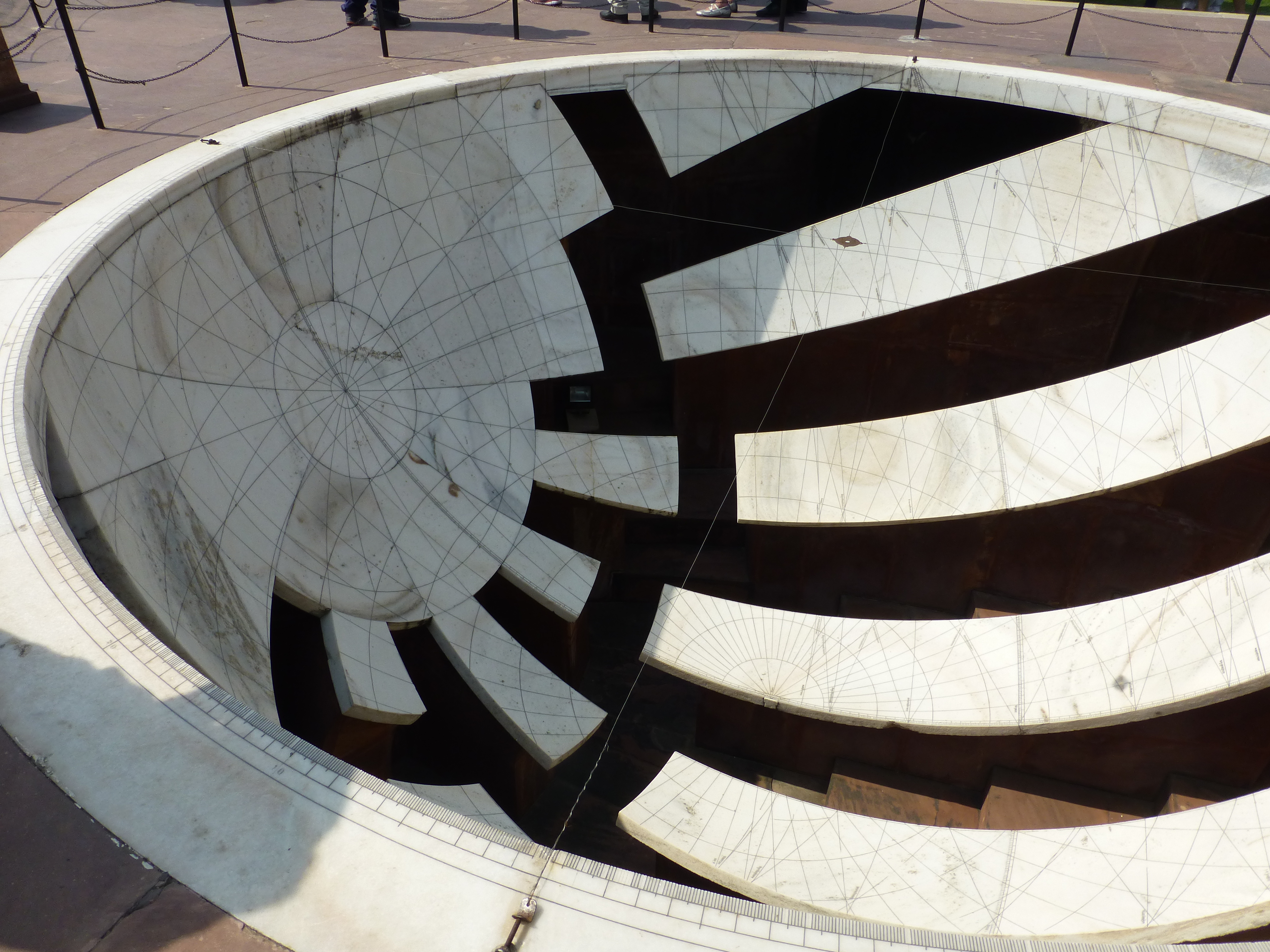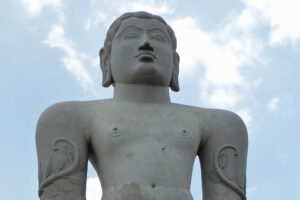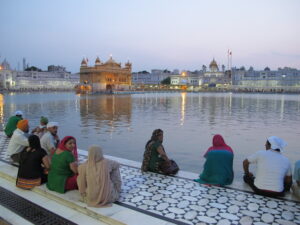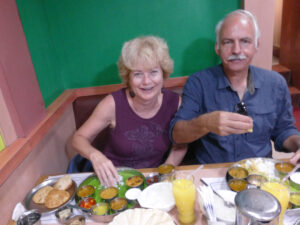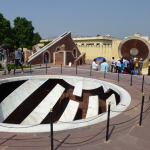
Entering the huge rectangular courtyard in Jaipur is like coming into a small walled palace, which would not be surprising in a town like this with old and new palaces all around. A low gate from the street interrupts the simply decorated walls that surround the place.
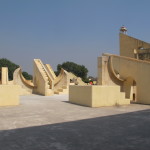
Inside, however, you find not an orderly maharaja’s pleasure garden or a typically maze-like complex of princely buildings. Instead, disorientation. A tall triangular structure with a single window over there, but otherwise everything low to the ground. A set of huge metal discs hanging like massive earrings over here. Only a few patches of grass. Two elliptical white soup-bowls fit for some giant in the mid-ground. And tightly packed throughout a number of Euclidean sculptures, all arcs and lines and angles. No palace elsewhere is like this.
Rather, these oddities are the tools of the astrologer’s trade, not made of brass and manipulated by hand, but constructed of brick, stone and stucco.
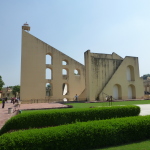
That tall triangular building is really a 27 meter high “gnomon” for a big sundial below, calibrated to tell the time within two seconds. The hypotenuse, as with the angles of so many other pieces here, is pitched at 27 degrees, the latitude of Jaipur. One such slab paradoxically points right to a later feature of the city, the clock tower in the distance.
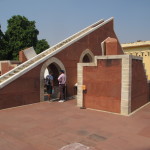
The little sister of the tall sundial near the gate is a similar construct whose gnomon casts shadows on a sandstone arc with 20 seconds of accuracy.

A circular chronometer just past it looks like a small Stonehenge complete. Its radial sandstone blocks that can tell you the time anywhere on the globe.
Those two soup bowls measure the astronomical position of the sun and stars during daylight hours.
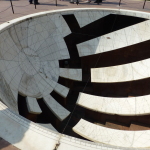
Nearby a cluster of twelve sandstone arcs, one for each sign of the zodiac and each bisected by short triangular walls, determines how the stars are ascending or descending at any given time.
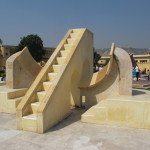
This astrological sculpture garden, the Jantar Mantar, dates from the early 18th century. The name means “calculation instrument” or what we might now call a computer. Close to the palace in Jaipur’s old city, it was constructed by the founder of “Jai-town,” the eponymous Jai Singh II. He was one of the Rajput princes of what was then called Rajputana, and ruled his clan’s domain from the great fort and palace of Amber nearby.

Jai Singh strongly believed in the ancient astrological arts. That faith accorded with the ardent beliefs of the Mughal rulers of central India, who originally came from the Middle East. Muslim and Hindu celestial beliefs aligned well as they both derived from Ptolemy and Hellenic science.
So he was not alone in his faith in the stars. In Jaisalmer, for example, a room in the villa or haveli of the Pawans, a family of wealthy merchants from the early 18th century, displays a roomful of astrolabes and other hand-held tools that they used for making decisions.

Even today, arranged marriages in India demand the casting of horoscopes for a potential bride and groom to determine how compatible they are in temperament, forecast any problems and resolve the ideal timing for the marriage. Oddly, it seems the end of the year is an excellent time for so many of those marriages. Even so, it’s critical to know the date and time of one’s birth in order to yield accurate results. So a new child may be charted from the start, and named appropriately. If signs are inauspicious, then the parents might need to take care to protect the child from potential evils.
His palace computer shows how much Jai Singh cared deeply to know what was written in the heavens: when action and inaction were propitious, or when an enterprise could prove successful or fail. And he spent liberally to create this huge astrologer’s workshop, as well as a smaller version in Delhi a few years earlier. At Jantar Mantar, or for less royal people in their own chart room, the answers could be found.
We couldn’t tell how diligently the Rajput prince might have acted on the advice of his astrologers, or how adept the smart ones became at giving him the answers he wanted.
But he must have done something right because he ruled for nearly half a century, a period when the money clearly flowed in as well as out. In the great wheel of time, however, his empire fell apart, as his successors fought among themselves and were imperiled by stronger Rajputana clans. Eventually later Rajputs of Jaipur worked out a deal with the British to keep their rights and privileges in return for cooperation with the new crown in town.
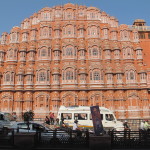
Whether they were fortunate or crafty matters little now. But some of the splendor still stands, in marvels like Jai Singh’s original palace and other remnants of his time like Jantar Mantar, open to the public as museums. His city has become the capital of Rajasthan, and home to 3 million people.
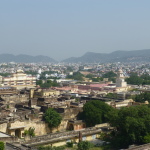
Even in democratic India, his successors are still nominally Rajput princes, living now in a somewhat newer part of the palace complex, a seven-storey pyramidal structure looming over the old one. They frequently contend with the government about their privileges and wealth, and their rulership is largely ceremonial at festivals. As with many castles in Europe, the public can even tour their home, for just 2500 rupees.
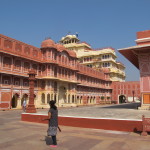
We chose not to help subsidize the royal family, though we were charmed by the rest of what we saw: the grand meeting plazas and pink facades of the old palace, the few refurbished buildings set within the courtyards, the frothy reception room for heads of state now decked out with portraits of all the Jaipur rajputs, and the artfully painted doorways of the four seasons under the watchful eye of the current royals.
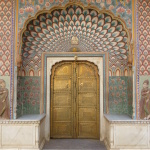
Their stars apparently are still favorable. The public loves to crowd in to see how the other half lived – and lives. We understand the awe foreigners feel at the magnificence of the rooms and the dazzle of the Rajput lifestyle. In other Rajput palaces, the impression is even more stunning due to all the silver and gold trinkets, the minutely realized paintings and other artifacts on display. Also, Jaipur’s people and other Indians do seem to appreciate the pomp and historical importance that the royals still bring to ceremonial occasions.
But we can’t help wonder what else Indians feel, bustling through these palaces. when they view what the Rajputs bought and built with the wealth their predecessors yielded up.
(Also, for more pictures from India, CLICK HERE to view the slideshow at the end of the India itinerary page.


